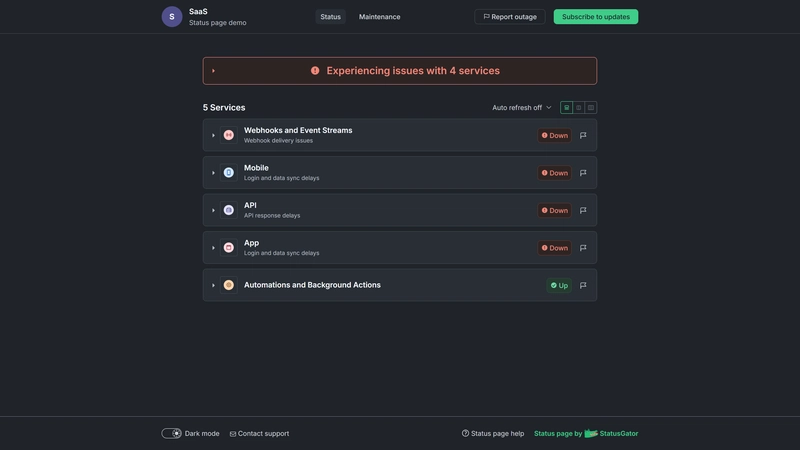7 SaaS Status Page Providers
When running a SaaS business, transparency is everything, especially when things go wrong. A SaaS status page provides real-time updates to customers during outages, incidents, or scheduled maintenance, reducing support tickets and boosting trust. Instead of leaving users in the dark, it keeps them informed with clear, timely communication. Beyond incident communication, a good status page offers system health monitoring, incident history, and automated notifications via email, SMS, or other channels. It’s an essential tool for customer experience and internal operations, especially for SaaS providers with complex infrastructure and third-party dependencies. In this post, we’ll explore some of the best SaaS status page providers available today, including tools that support public and private pages, incident workflows, and integrations with your existing stack. We won't be looking at some popular tools like Statuspage.io, UptimeRobot, and Uptime Kuma since these have been covered quite extensively already. 1. StatusGator StatusGator helps SaaS companies stay ahead of outages, not just on their own platform but also across third-party services. It aggregates the status of over 5,000 cloud services, providing a centralized view of your entire infrastructure stack on a single SaaS status page. StatusGator helps deliver both transparency and uptime via customizable public and private status pages that track hosting providers, APIs, payment gateways, and more. Whether you rely on services like AWS, Stripe, or Square, StatusGator helps your team stay informed and respond to disruptions before they affect your users. What makes StatusGator stand out? One of StatusGator’s standout features is Early Warning Signals,is Early Warning Signals, which detects service anomalies before they're officially acknowledged. During major outages, like the Square downtime in February 2025, StatusGator alerted users several minutes ahead of the provider’s own announcement, giving IT teams a critical head start. In addition to early detection, StatusGator offers: Real-time alerts via email, Slack, Microsoft Teams, and webhooks. Branded public SaaS status pages to communicate incidents with users. Internal status pages for IT and engineering teams. Private API monitoring for enterprise-level transparency. Reduced support burden by addressing user concerns before they reach your help desk. StatusGator is especially valuable for SaaS platforms with complex tech stacks and multiple integrations. Consolidating third-party monitoring into a single status page, it fills a gap that traditional monitoring tools don’t cover. Whether you’re building trust with users through a public-facing status page or equipping your team with an internal dashboard to track critical vendors, StatusGator is a must-have for modern SaaS operations.

When running a SaaS business, transparency is everything, especially when things go wrong. A SaaS status page provides real-time updates to customers during outages, incidents, or scheduled maintenance, reducing support tickets and boosting trust. Instead of leaving users in the dark, it keeps them informed with clear, timely communication.
Beyond incident communication, a good status page offers system health monitoring, incident history, and automated notifications via email, SMS, or other channels.
It’s an essential tool for customer experience and internal operations, especially for SaaS providers with complex infrastructure and third-party dependencies.
In this post, we’ll explore some of the best SaaS status page providers available today, including tools that support public and private pages, incident workflows, and integrations with your existing stack.
We won't be looking at some popular tools like Statuspage.io, UptimeRobot, and Uptime Kuma since these have been covered quite extensively already.
1. StatusGator

StatusGator helps SaaS companies stay ahead of outages, not just on their own platform but also across third-party services. It aggregates the status of over 5,000 cloud services, providing a centralized view of your entire infrastructure stack on a single SaaS status page.
StatusGator helps deliver both transparency and uptime via customizable public and private status pages that track hosting providers, APIs, payment gateways, and more. Whether you rely on services like AWS, Stripe, or Square, StatusGator helps your team stay informed and respond to disruptions before they affect your users.
What makes StatusGator stand out?
One of StatusGator’s standout features is Early Warning Signals,is Early Warning Signals, which detects service anomalies before they're officially acknowledged. During major outages, like the Square downtime in February 2025, StatusGator alerted users several minutes ahead of the provider’s own announcement, giving IT teams a critical head start.
In addition to early detection, StatusGator offers:
- Real-time alerts via email, Slack, Microsoft Teams, and webhooks.
- Branded public SaaS status pages to communicate incidents with users.
- Internal status pages for IT and engineering teams.
- Private API monitoring for enterprise-level transparency.
- Reduced support burden by addressing user concerns before they reach your help desk.
StatusGator is especially valuable for SaaS platforms with complex tech stacks and multiple integrations. Consolidating third-party monitoring into a single status page, it fills a gap that traditional monitoring tools don’t cover.
Whether you’re building trust with users through a public-facing status page or equipping your team with an internal dashboard to track critical vendors, StatusGator is a must-have for modern SaaS operations.










































































































































































![[The AI Show Episode 144]: ChatGPT’s New Memory, Shopify CEO’s Leaked “AI First” Memo, Google Cloud Next Releases, o3 and o4-mini Coming Soon & Llama 4’s Rocky Launch](https://www.marketingaiinstitute.com/hubfs/ep%20144%20cover.png)


















































































































![[DEALS] The All-in-One Microsoft Office Pro 2019 for Windows: Lifetime License + Windows 11 Pro Bundle (89% off) & Other Deals Up To 98% Off](https://www.javacodegeeks.com/wp-content/uploads/2012/12/jcg-logo.jpg)





































![Is this too much for a modular monolith system? [closed]](https://i.sstatic.net/pYL1nsfg.png)






















































































































_Andreas_Prott_Alamy.jpg?width=1280&auto=webp&quality=80&disable=upscale#)
































































































![What features do you get with Gemini Advanced? [April 2025]](https://i0.wp.com/9to5google.com/wp-content/uploads/sites/4/2024/02/gemini-advanced-cover.jpg?resize=1200%2C628&quality=82&strip=all&ssl=1)













![Apple Shares Official Trailer for 'Long Way Home' Starring Ewan McGregor and Charley Boorman [Video]](https://www.iclarified.com/images/news/97069/97069/97069-640.jpg)
![Apple Watch Series 10 Back On Sale for $299! [Lowest Price Ever]](https://www.iclarified.com/images/news/96657/96657/96657-640.jpg)
![EU Postpones Apple App Store Fines Amid Tariff Negotiations [Report]](https://www.iclarified.com/images/news/97068/97068/97068-640.jpg)
![Apple Slips to Fifth in China's Smartphone Market with 9% Decline [Report]](https://www.iclarified.com/images/news/97065/97065/97065-640.jpg)




































































































































